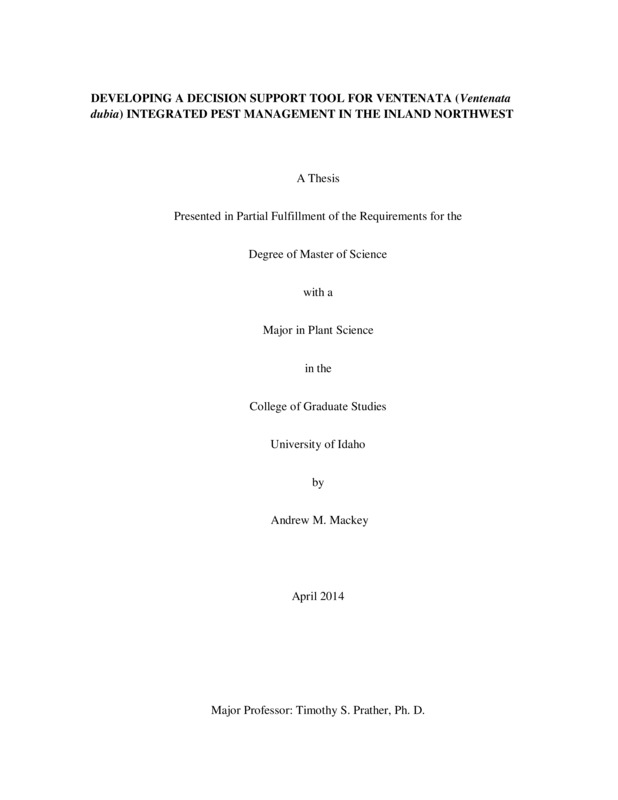Developing a Decision Support Tool for Ventenata (Ventenata dubia) Integrated Pest Management in the Inland Northwest
Mackey, Andrew. (2014). Developing a Decision Support Tool for Ventenata (Ventenata dubia) Integrated Pest Management in the Inland Northwest. Theses and Dissertations Collection, University of Idaho Library Digital Collections. https://www.lib.uidaho.edu/digital/etd/items/mackey_idaho_0089m_10189.html
- Title:
- Developing a Decision Support Tool for Ventenata (Ventenata dubia) Integrated Pest Management in the Inland Northwest
- Author:
- Mackey, Andrew
- Date:
- 2014
- Program:
- Plant, Soil and Entomological Sciences
- Subject Category:
- Plant sciences; Wildlife management
- Abstract:
-
Ventenata [Ventenata dubia (Leers) Coss.] is a non-native winter annual grass that has invaded agricultural and rangeland systems throughout the Pacific Northwest. Ventenata invasion reduces timothy hay crop profitability, causes reductions in plant species diversity in Conservation Reserve Program (CRP) and is negatively impacting wildlife in CRP. This research project focused on developing integrated pest management techniques for timothy hay and CRP, as well as documenting the effects ventenata invasion has on wildlife in CRP. In both agricultural systems we evaluated treatment efficacy in two infestations of ventenata (low <25% foliar cover vs. high >50% foliar cover). We evaluated fertilize-only, fall herbicide only (flufenacet plus metribuzin), fertilize plus herbicide and a control treatment at 5 cm and 10 cm harvest heights in timothy hay. In CRP, we evaluated the following treatments alone and paired with a fall herbicide (sulfosulfuron): fall prescribed burn, spring prescribed burn, sickle mow and remove, rotary mow, fertilize, and a control. We found that greater control of ventenata can be achieved by integrating treatments and treatments respond differently depending on infestation level. In timothy, we found that timothy yield and ventenata control trended to be greater at the 10 cm harvest height but did not differ significantly. The fertilize plus herbicide treatment performed the best in controlling ventenata and increasing yield regardless of infestation level, whereas fertilize-only treatments increased ventenata biomass in low infestations but decreased biomass in high infestations. CRP treatments responded differently in ventenata control at the two infestation levels however, fall prescribed burn plus herbicide performed the best in both situations. Both the mow-only and mow and remove-only treatments increased ventenata biomass and percent foliar cover. Furthermore, reproduction of tree swallows was lower in areas with >50% foliar cover of ventenata compared to areas with <10% foliar cover of ventenata. Our results will enable land managers to better control ventenata infestations by integrating prescribed burning, fertilizer, harvest height and herbicide. The decision support tool that we developed provides an effective tool for land managers and producers to apply the most appropriate set of control measures given the infestation level of ventenata conditions. Additionally, we have documented negative impacts to wildlife caused by ventenata invasion, highlighting the need for natural resource professionals to initiate control measures now to minimize impacts to other wildlife species and limit or prevent the spread of ventenata.
- Description:
- masters, M.S., Plant, Soil and Entomological Sciences -- University of Idaho - College of Graduate Studies, 2014
- Major Professor:
- Prather, Timothy S
- Committee:
- Conway, Courtney; Shewmaker, Glen
- Defense Date:
- 2014
- Identifier:
- Mackey_idaho_0089M_10189
- Type:
- Text
- Format Original:
- Format:
- application/pdf
- Rights:
- In Copyright - Educational Use Permitted. For more information, please contact University of Idaho Library Special Collections and Archives Department at libspec@uidaho.edu.
- Standardized Rights:
- http://rightsstatements.org/vocab/InC-EDU/1.0/

